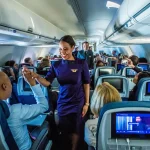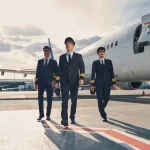If you’ve ever flown with an infant, you know it’s a different kind of travel altogether. It’s less about upgrades and lounges and more about nap schedules, milk temperatures, and keeping your baby calm at 30,000 feet. I’ve flown dozens of times with my kids, starting from their first months, and Delta Airlines has consistently offered a solid experience for parents traveling with infants. That said, the policies can be confusing if you’re not familiar with them, and knowing exactly what to expect can make your trip significantly less stressful.
In this guide, I’ll break down everything you need to know about traveling with a baby on Delta, whether you’re flying domestic or international, using a bassinet, holding your infant in your lap, or booking a separate seat. I’ve done all of these, and I’ve had both flawless and chaotic experiences. This article is here to help you lean toward the former.
What Counts as an Infant on Delta?
Delta defines an infant as a child under 2 years old (24 months) on the date of travel. Once your child turns two, they are required to occupy their own seat with a paid fare, even if they’re still small enough to fit comfortably in your lap.
If your child is under two, you have two main options:
- Lap infant: Your baby flies without their own seat, sharing your lap for the duration of the flight.
- Ticketed infant: Your baby has their own seat and must be secured in an FAA-approved child restraint system, such as a car seat.
For shorter flights, I’ve personally flown with my infant as a lap child, it’s convenient and free on most domestic routes. But for longer international flights, I always book a separate seat and bring the car seat. It’s safer, more comfortable, and much easier when it comes to naps and feeding.
Can an Infant Fly Free on Delta?
Yes, but only on domestic flights within the United States. If you’re flying with your infant as a lap child, Delta allows one infant per adult to travel free of charge without a seat.
For international flights, the policy is different. Even as a lap child, your infant is still subject to taxes and fees, typically calculated as a percentage of the adult fare. This can vary based on the destination and the specific fare class. When I flew from New York to London with my son as a lap infant, I paid about 10% of my ticket price, plus international taxes and surcharges. Delta required that portion to be paid in advance, and the infant had to be added to the reservation directly over the phone.
If you’re flying with twins or more than one child under two, each infant must have their own accompanying adult, or you’ll need to purchase a separate seat for one of the babies. You’re not allowed to have two lap infants per adult for safety reasons.
Should You Book a Seat for Your Infant?
Delta doesn’t require you to buy a seat for your infant under 2, but they strongly recommend it, especially for longer flights. The FAA also advises that the safest way for a child under two to fly is in a car seat or child safety restraint system secured in their own seat.
When I first flew with my baby on a five-hour flight, I held him the entire time, and by the end of it, my arms, back, and patience were completely worn out. Since then, I’ve always booked a separate seat and brought our car seat on board. It’s worth every dollar for the safety, convenience, and ability to relax even slightly during the flight.
Delta allows rear-facing car seats for infants, as long as they are FAA-approved and fit within the seat dimensions. If the seat is too large or obstructs other passengers, flight attendants may require you to adjust the setup. I always check my car seat width ahead of time and choose a window seat so it doesn’t block aisle access.
Are Bassinets Available on Delta Flights?
Delta does provide onboard bassinets, also called skycots, but only on select international flights and only in specific cabins, typically Delta One or Delta Premium Select. The bassinets must be reserved in advance, and availability is limited to aircraft and seat configurations that support them.
Here’s what I’ve learned from using them:
- You’ll need to call Delta Reservations as soon as your ticket is booked to request a bassinet.
- Bassinets are typically installed at the bulkhead row, so your seat assignment must match.
- There are weight and size restrictions, generally for infants under 20 pounds and less than 26 inches in length.
- You cannot use the bassinet during taxi, takeoff, or landing.
I’ve used the bassinet on an Airbus A330 flying to Europe, and while it was a lifesaver during cruise, it’s not large enough for older or longer babies. If your child is over six months old or particularly active, they may not stay in it long enough to justify the effort. Still, it’s a valuable option for babies under 6 months. If you’re deciding what to bring versus rent, these top travel pack and play cribs are a practical starting point.
What Documentation Is Required for an Infant?
For domestic flights, infants traveling as lap children generally don’t need identification. However, Delta may request proof of age, especially if the child appears older than two. I always bring a copy of the birth certificate or passport, just in case.
For international flights, a passport is required for all infants, regardless of age. In some cases, additional documentation such as a notarized letter of consent is needed if only one parent is traveling or if the country you’re visiting has strict entry requirements for minors.
You can’t check in online for international infant tickets, you’ll need to complete the process at the airport with documents in hand. If you’re planning a pregnancy-to-infant travel timeline, the Delta pregnancy travel policy helps you set expectations earlier.
Does Delta Allow Strollers and Car Seats for Free?
Yes. Delta allows you to check one stroller and one car seat per child for free. You can check them:
- At the ticket counter
- At the gate (recommended if you need the stroller through the airport)
I typically check the car seat at the gate and the stroller at check-in if I’m using a carrier in the terminal. The gate-tagging process is fast, and Delta staff have always handled both items with care in my experience.
For larger strollers, I recommend using a stroller travel bag to prevent damage. For car seats, Delta doesn’t provide covers, so bring your own or use a padded backpack-style case.
Feeding and Diapering Onboard
Feeding your infant during takeoff and landing is helpful for preventing ear pressure discomfort. Whether breastfeeding or bottle-feeding, Delta supports both options and does not impose any restrictions. I’ve never had an issue nursing on board, even in Economy.
Most Delta aircraft have changing tables in at least one lavatory. On larger aircraft like the A350 or 767, there may be multiple restrooms with changing tables. That said, space is tight, so prepare accordingly.
I bring a small diaper kit with wipes, two diapers, and a disposable changing pad in a zip bag so I can grab it easily without digging through my carry-on in the aisle.
Is Delta a Good Choice for Flying with an Infant?
From my experience, Delta does a great job supporting families traveling with infants. The policies are clear, the fees are reasonable (especially for lap infants), and the crew is usually patient and helpful. What matters most is that you prepare well, bring the right documents, call ahead to arrange bassinet or lap infant reservations, and pack smartly for the flight.
Traveling with a baby isn’t always easy, but with the right setup and realistic expectations, it can absolutely be manageable, and sometimes even enjoyable.
Frequently Asked Questions
Can I bring both a stroller and a car seat on Delta?
Yes. One stroller and one car seat per child are allowed for free.
Is my infant’s fare really free on domestic flights?
Yes, for lap infants. However, they still need to be added to the reservation.
Can I use a bassinet on every Delta flight?
No. Bassinets are only available on select international aircraft and in specific cabins.
Do I need a passport for my infant on international flights?
Yes. Every child, regardless of age, must have a valid passport for international travel.
Can I earn SkyMiles for my infant?
Only if the infant has a ticketed seat. Lap infants do not earn SkyMiles.
Baby gear often turns into “extra bags,” so checking United personal item size helps you compare what typically fits under-seat across airlines.





